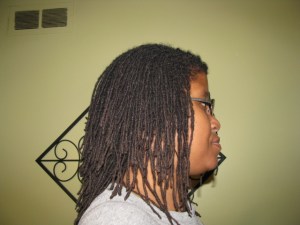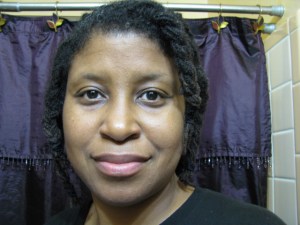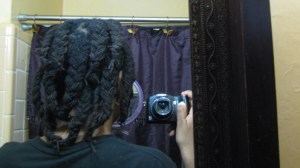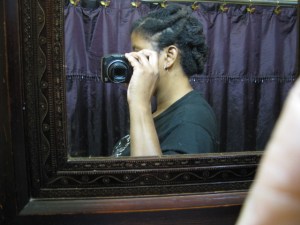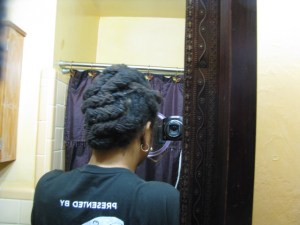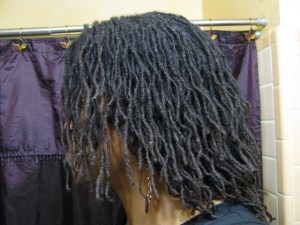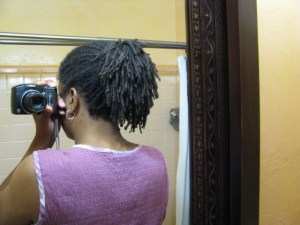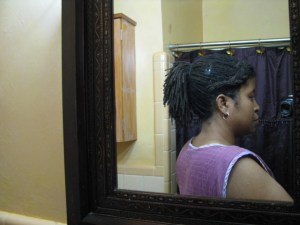OK I’m back to discuss the second part in the email where I think she is asking how to prevent lint from getting into locs.
“…Secondly i am in the process of removing one of daughter’s locs due to unsightly lint, so much that when i look at it, i lose the joy! Yet, I don’t have any except at the back row. Please help!..”
Again, I’m not a hair scientist so what I’m offering is my opinion based on critical thought of what I’ve observed on my hair. I think what products one uses plays a huge part in this. Commercial products containing things like mineral oil, lanolin, alcohol-the same ingredients that contributes to dry hair, seems to make our locs more of a magnet for lint.
However, some natural ingredients beeswax, and shea butter can be lint attractors as well.

A woman processes Shea tree nuts into Shea butter. Shea butter comes from the nuts of the Shea tree (Parkia biglobosa), and for women in poor rural comunities it can provide a pathway out of poverty. (Photo credit: Wikipedia)
Shea butter while an excellent ingredient for helping our hair and skin lock in moisture, is a little waxy in texture. That’s what makes it a bit hard to wash out of the hair. Not a problem with loose hair-big problem with locked hair. I don’t even have to mention beeswax.
Some oils may react on your hair this way as well. Olive oil, castor oil and lemongrass essential oil produce that sticky and slightly waxy feel on my hair. This is something one needs to pay attention to because oils react differently on everyone’s hair because we don’t all have the same hair texture.
I’m gonna go out on a limb and say I think some of the shampoos and conditioners that we use might also play a part in locs attracting lint. Linty clothes, hats, scarfs, pillow cases and sheets are culprits as well.
And last but certainly not least, the towels or whatever we are using to dry our locs after washing.
Have I had the problem described in the email? Yes. It’s one of the “issues” I said I was going to talk about in my 5 year update. Though it does seem like a combination of lint, build up from products and oils that I had used in the early days of my braidlock journey. While in the 1st year of my journey I was not using any oils, I had used bath towels to dry my locs after washing. And I had started using Dr. Bronner’s soap which has olive oil-I’ve already mentioned how olive oil works on my hair.
Then in the beginning of year 2, I started using conditioner ( the one that goes with the Suave clarifying shampoo) on my locs. I also used the Profectiv Strengther and I used a whipped coconut oil with a tiny amount of shea butter in it. None of these practices lasted long, but long enough to where I’m seeing the effects of using those items in my locs at the 4.5-5 year mark.
Now I had stopped using bath towels before the 2 year mark, briefly using a black pillow case and then I switched to ShamWow (?) towels to dry my locs. At the time I was washing my locs 2-3 times a week to combat my oily flaky scalp problem, so I need something to dry my hair during the winter.
But I’m wondering why am I having this issue when 1) my locs were short. 2) The ends of some of my back locs were hard early in my journey. 3) I rarely wear hats and the hats I did wear were black. 4) In the winter my locs were pretty much kept covered with a satin-like cap and they were a long way from my back thereby not touching my clothes. 5) I sleep on a satin-like pillowcase I made very early on in my journey.
What I’ve noticed is the raw African Black Soap has been acting like a gentle clarifier, which is a good thing. Over time, the ends that were rock hard have been gradually softening up and starting late last year-early this year, opening up. As a result, it’s coming up to the surface and/or releasing the stuff on its own. Some I have picked out which means I’ve lost some length on those locs and the locs which have done the task on their own. So yes, a frustrating setback but not enough to make me want to start my journey over.
In the recent few weeks, I’ve also done a deep clean using a bit of Dawn, yep the same Dawn that you wash dishes with, and a bit of baking soda by putting my locs in a small bucket with very hot water. The pic in the last post, is after the deep cleanse.
Since I liked the results, I decided to deep cleanse every week with baking soda only, following up with another natural gentle shampoo that I’ll review later. I still love my Black Soap but I have been using it for a little over 3 years and wanted to try something different.
So this is one of the ways I’m going to use to prevent lint/buildup in the future as I really like how the baking soda seems to encourage the stuff to come to the surface to be washed away. A step that’s probably needed with locs since it’s hair that’s very close together.. different from loose hair. And it seems to make the locs fluffy and light. Funny because I know I used baking soda to wash so I wonder if I had kept up with that practice, I might not have these issues now.
The second method I have used for about 2.5 years now is not using anything to dry my braidlocks. When I say air dry, that’s exactly what I mean…100% air dry. Also I still sleep with my satin-like material on my pillow.
The last method is sticking with (no pun intended) a light oil that does not have a sticky feel to it on my hair.
Ooo, something else I just thought of, the moisturizer we put on our neck. I looked back at my early pics and noticed spots in those locks at the nape of the neck…way back then. I was definitely using whipped shea butter on my body so it’s not hard to imagine that some can rub off on those nape area locs. And as most folks do-take a shower, moisturize our skin, then style our hair. Residue from the moisturizer on our hands might be ending up in our locs and not getting completely washed out on wash day. This thought occurred to me as I’m noticing my nape locs don’t seem to have this issue anymore. Maybe because I haven’t used shea butter for some time now as a moisturizer. I stopped last year during the summer as it’s too heavy for summer use and never started back during the winter. Hmmm…might be something to try-using a light oil for your neck instead of a creamy product.
I hope that gives some food for thought on what I’m doing to prevent future lint and buildup in my locs. What are some of the things you all are doing?























